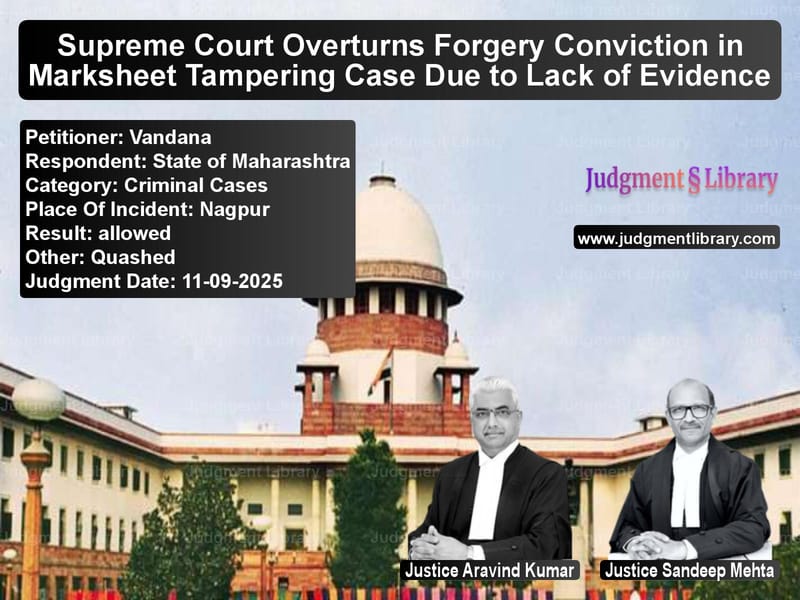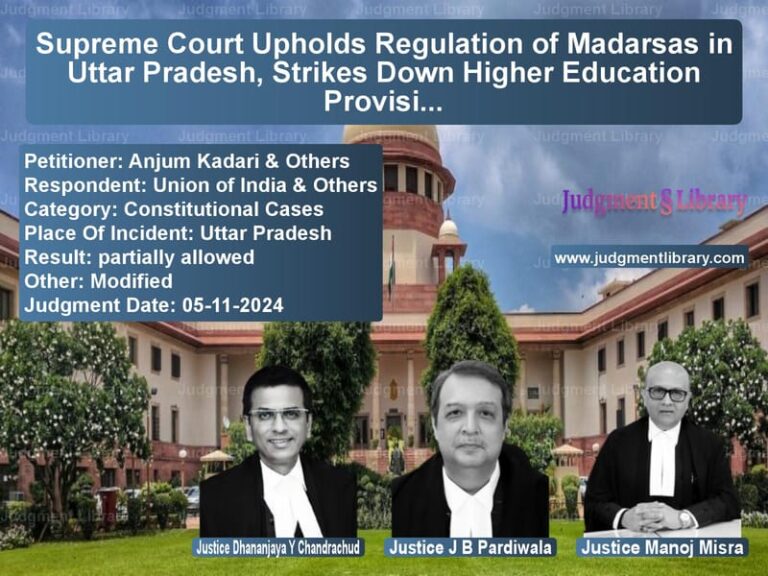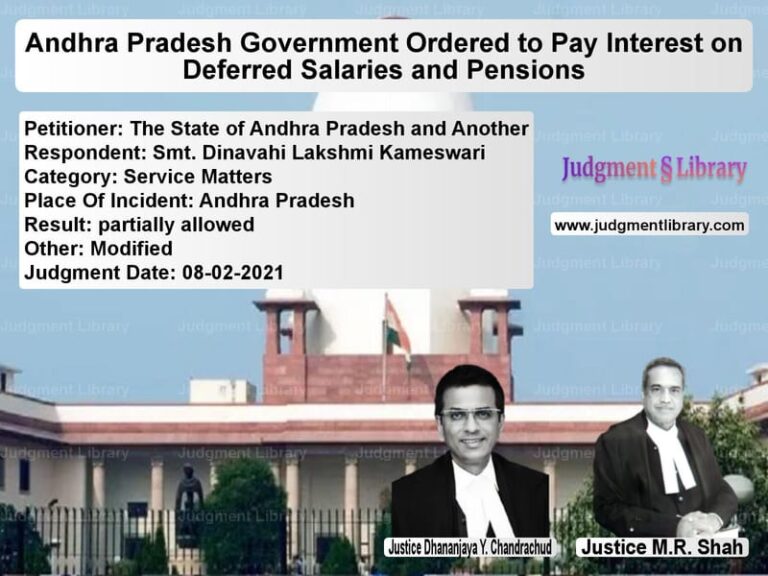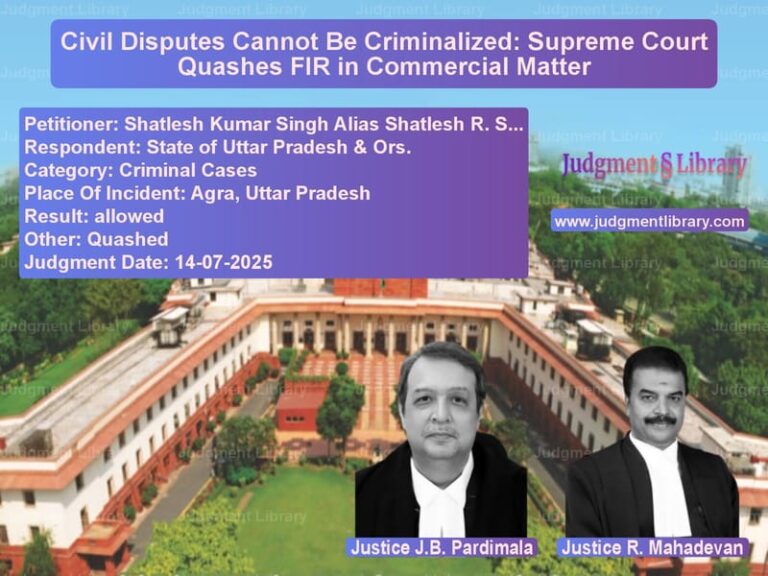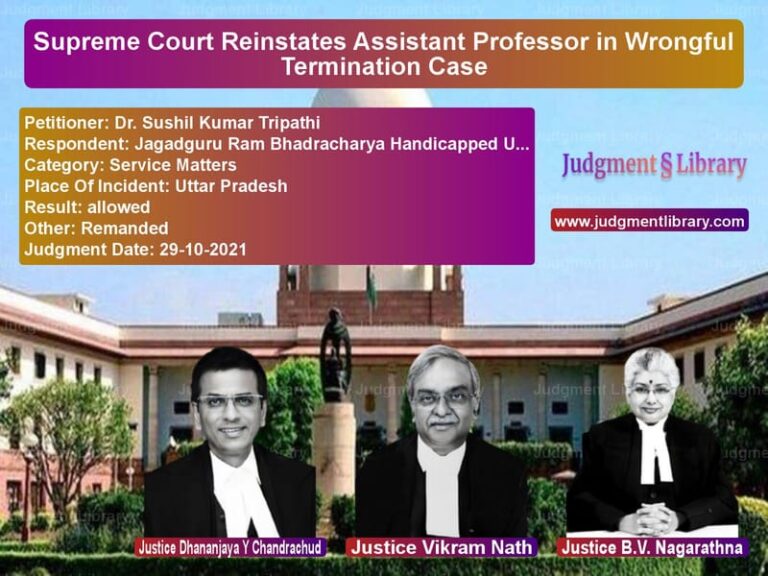Supreme Court Overturns Forgery Conviction in Marksheet Tampering Case Due to Lack of Evidence
In a significant ruling that underscores the fundamental principles of criminal law, the Supreme Court of India has set aside the conviction of a woman accused of forging her university marksheet to secure admission. The judgment, delivered on September 11, 2025, highlights the critical importance of proving guilt beyond a reasonable doubt and the dangers of relying on mere suspicion. The case, which spanned nearly two decades, involved allegations that the appellant, Vandana, had tampered with her marks in a compulsory English paper to gain entry into the third year of her Bachelor of Social Work (BSW) course.
The story begins in 1998 when Vandana was a student at Aniket College of Social Work, affiliated with Nagpur University. She appeared for her BSW Part-I summer session examinations and secured only 5 marks in the compulsory English subject. After applying for revaluation, her marks increased to 10, but this was still insufficient to pass. Consequently, she was declared as failed. Despite this setback, she proceeded to apply for admission to the BSW Part-III course. She submitted her admission form along with her original marksheet and the revaluation notification. These documents were received and verified by the college’s admission clerk and subsequently attested and signed by the principal before being forwarded to the university for processing.
It was at the university’s examination department that the alleged forgery was detected. The prosecution claimed that the marks in the compulsory English subject had been altered from “10” to “18” on the marksheet and from “10” to “30” on the revaluation notification. Based on these allegedly tampered documents, Vandana had sought admission. The university cancelled her admission, and an FIR was registered. After an investigation, she was charge-sheeted. During the trial, two other accused—the admission clerk and the principal—were also implicated. The trial court convicted all three. However, on appeal and subsequent revision, the co-accused (the clerk and the principal) were acquitted, while Vandana’s conviction was upheld. It was against this backdrop that she approached the Supreme Court.
The Arguments Presented
The Learned Counsel for the appellant submitted a series of compelling arguments challenging the conviction. He pointed out that the Impugned Judgement overlooked the evidentiary infirmities in the prosecution’s case particularly in the light of absence of any handwriting expert or forensic verification of the allegedly forged marksheet or notification and still proceeded to convict the appellant. He further argued that overwriting seen by bare eyes without expert corroboration is an unsafe basis for criminal conviction in light of the standard of proof required under the criminal law. Another critical point raised was that no university official who prepared or dispatched the worksheet or notification was examined as witness, depriving the accused of a fair opportunity to challenged the chain of custody or authorship of the documents. Regarding the charge of cheating, the counsel contended that the basic requirement under section 420 IPC that the accused must have induced a person fraudulently or dishonestly to deliver property was not proved especially in the light of the fact that the University admitted the student on documents certified by the college. Lastly, he submitted that Exh. 37 (original) and Exh. 36 (Alleged Tampered Copy) were not proved to be materially inconsistent in a manner that would attribute forgery to the appellant alone.
In response, the Learned Counsel appearing on behalf of the Respondent vehemently supported the Impugned Judgement of conviction and sentence and prayed for dismissal of the appeal.
The Supreme Court’s Analysis
The Supreme Court, comprising Justices Aravind Kumar and Sandeep Mehta, meticulously analyzed the case. The court began by examining the relevant legal provisions—Sections 420 (Cheating), 468 (Forgery for purpose of cheating), and 471 (Using as genuine a forged document) of the Indian Penal Code. The court noted that to secure a conviction under these sections, the prosecution must prove specific elements, including the making of a false document and the intent to cheat.
The court identified several fatal flaws in the prosecution’s case. Firstly, it focused on the chain of custody of the disputed documents. The mark-sheet and the revaluation notification went through a chain of custody. Firstly, from appellant to admission clerk and after the admission clerk had verified and received the alleged documents then the custody was routed to the principal of the college. The prosecution had failed to prove, by any reliable evidence, that the alleged tampering was effected by Appellant herself or while the documents were in the exclusive custody and control of the appellant this tampering had occurred. On the contrary, the material evidence would disclose that the documents passed through institutional hands for scrutiny, endorsement and forwarding and at certain points of time it was not in the custody of appellant at all. In such circumstances, the passing of the alleged document through the hands of several person before it was detected as forged renders unsafe to arrive at a conclusion that appellant had authored the tampering or possessed the contemporaneous knowledge of such tampering. The court powerfully reiterated a foundational legal principle: It is apt to mention that it is well-established principle of law that suspicion, howsoever grave, cannot replace the standard of legal proof.
Secondly, the court addressed the complete lack of forensic evidence. The court below have rested essentially on visual inference of overwriting to hold tampering stood established. No handwriting or forensic expert opinion was obtained regarding the authorship of alleged tampering. The court cited its own landmark judgment in Fakhruddin v. State of Madhya Pradesh, where it was observed: “Both under S. 45 and S. 47 the evidence is an opinion, in the former by a scientific comparison and in the latter on the basis of familiarity resulting from frequent observations and experience, In either case the Court must satisfy itself by such means as are open that the opinion may be acted upon… Where an expert’s opinion is given, the Court must see for itself and with the assistance of the expert come to its own conclusion whether it can safely be held that the two writings are by the same person.” While expert opinion is not always mandatory, the court held that in a case like this, where authorship was central to establishing guilt, the absence of any expert corroboration weighed heavily against the prosecution. Therefore, the courts below treated “apparent overwriting” as conclusive which approach is alien to the standard proof beyond reasonable doubt.
Thirdly, the court found that the prosecution had failed to prove mens rea, or a guilty mind, which is an essential ingredient for the offences charged. Even assuming the prosecution theory to be true namely, that documents were deployed to secure admission to BSW-III course, record do not establish the mens rea which is pre-requisite for Section 471 IPC (knowledge/reason to believe) or for attempt to cheat under Section 420 read with Section 511 IPC being present. The documents were stamped by college authorities and passed through administrative scrutiny. In the absence of evidence that the appellant had dishonest intention to either make the false document or knew of its falsity while submitting it, the mental status or mens rea remains unproved.
Fourthly, the court noted a serious procedural lapse during the trial. It found that the statement of the accused under Section 313 of the Code of Criminal Procedure, which is meant to give the accused an opportunity to explain incriminating evidence, was recorded improperly. It is found that several incriminating circumstances were put to the appellant in compound and omnibus questions as recorded by the appellate court. This court has constantly held and we reiterate that Section 313 is not an empty formality. Where there is failure to put material circumstances fairly and distinctly, it causes prejudice and vitiates reliance placed on such circumstances. The said defect strikes at a valuable statutory right of defence of the accused. In the present case, it is on record that the accused was not possibly able to understand the incriminating circumstances put against her and was not able to answer properly because of the compound questions. Nevertheless, the courts have relied upon the statement which in our considered view causes prejudice to the accused.
The Final Ruling and Legal Principles
In its concluding remarks, the Supreme Court summarized the settled legal principles that guided its decision: “(i) That the benefit of doubt follows when two views are reasonably possible; (ii) That the Suspicion however grave cannot substitute standard of legal proof; and (iii) That the exclusive control of the alleged forged document must be proved when there is lack of direct evidence to connect the alleged forgery to the accused especially in a case where the alleged document has passed through the hands of several persons before forgery is detected. If the same is not proved, at best, the evidence on record may arouse suspicion but they do not establish beyond reasonable doubt that the accused had forged, or knowingly used, or attempted to cheat by use of such forged documents.”
Therefore, in the light of aforesaid discussion, the appeal deserves to be allowed and accordingly, it stands Allowed and the conviction of the appellant under the Impugned order dated 08.05.2025 in Criminal Revision Application No. 78 of 2019 under Section 420 read with Section 511 IPC Sections 468 and 471 IPC together with the sentences imposed, are hereby set aside.
This judgment serves as a powerful reminder of the core tenets of criminal jurisprudence. It reinforces that a conviction cannot be based on conjecture or mere possibility. The prosecution must prove its case to the hilt, establishing every ingredient of the offence, including the physical act and the mental intention, with reliable and corroborative evidence. For Vandana, the ruling brings an end to a long legal battle, restoring her presumption of innocence, which the evidence on record was ultimately unable to rebut beyond a reasonable doubt.
Petitioner Name: Vandana.Respondent Name: State of Maharashtra.Judgment By: Justice Aravind Kumar, Justice Sandeep Mehta.Place Of Incident: Nagpur.Judgment Date: 11-09-2025.Result: allowed.
Don’t miss out on the full details! Download the complete judgment in PDF format below and gain valuable insights instantly!
Download Judgment: vandana-vs-state-of-maharashtra-supreme-court-of-india-judgment-dated-11-09-2025.pdf
Directly Download Judgment: Directly download this Judgment
See all petitions in Fraud and Forgery
See all petitions in Judgment by Aravind Kumar
See all petitions in Judgment by Sandeep Mehta
See all petitions in allowed
See all petitions in Quashed
See all petitions in supreme court of India judgments September 2025
See all petitions in 2025 judgments
See all posts in Criminal Cases Category
See all allowed petitions in Criminal Cases Category
See all Dismissed petitions in Criminal Cases Category
See all partially allowed petitions in Criminal Cases Category

